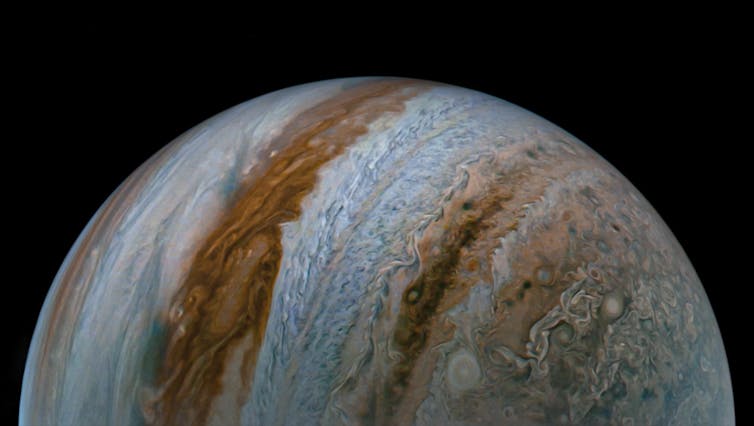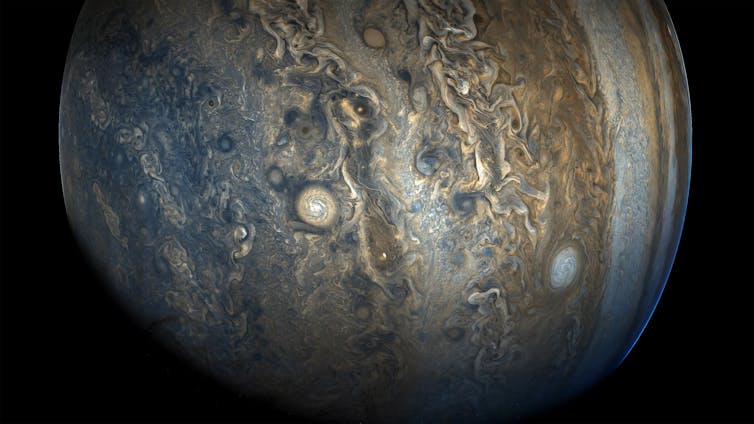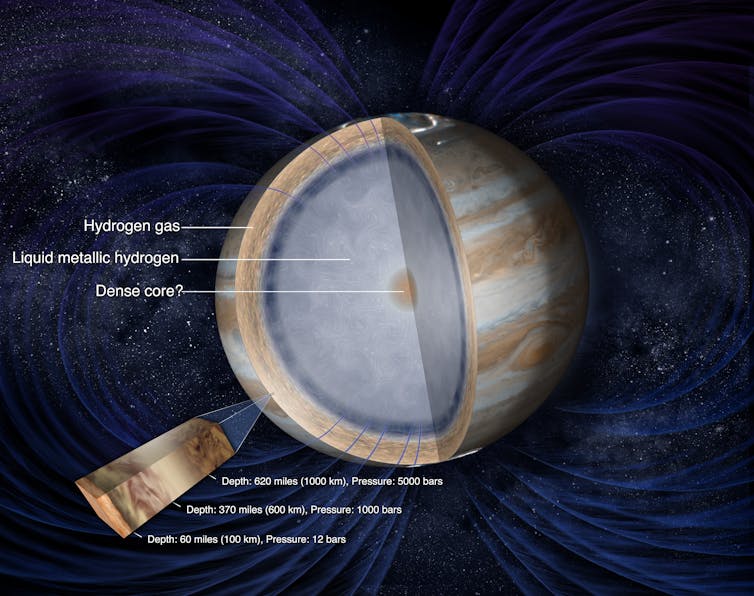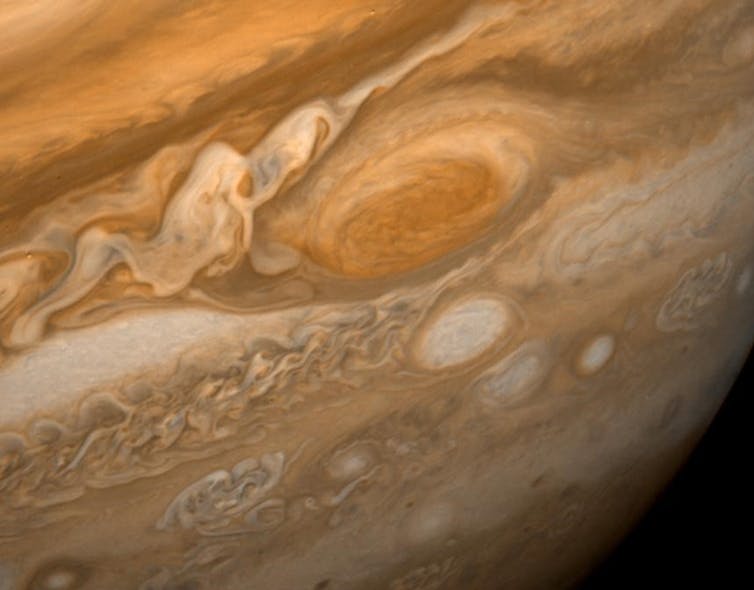[Source: @danbydraws]
How can Jupiter have no surface? A dive into a planet so big, it could swallow 1,000 Earths

Benjamin Roulston, Clarkson University

Curious Kids is a series for children of all ages. If you have a question you’d like an expert to answer, send it to [email protected].
Why does Jupiter look like it has a surface – even though it doesn’t have one? – Sejal, age 7, Bangalore, India
The planet Jupiter has no solid ground – no surface, like the grass or dirt you tread here on Earth. There’s nothing to walk on, and no place to land a spaceship.
But how can that be? If Jupiter doesn’t have a surface, what does it have? How can it hold together?
Even as a professor of physics who studies all kinds of unusual phenomena, I realize the concept of a world without a surface is difficult to fathom. Yet much about Jupiter remains a mystery, even as NASA’s robotic probe Juno begins its ninth year orbiting this strange planet.
First, some facts
Jupiter, the fifth planet from the Sun, is between Mars and Saturn. It’s the largest planet in the solar system, big enough for more than 1,000 Earths to fit inside, with room to spare.
While the four inner planets of the solar system – Mercury, Venus, Earth and Mars – are all made of solid, rocky material, Jupiter is a gas giant with a composition similar to the Sun; it’s a roiling, stormy, wildly turbulent ball of gas. Some places on Jupiter have winds of more than 400 mph (about 640 kilometers per hour), about three times faster than a Category 5 hurricane on Earth.

Searching for solid ground
Start from the top of Earth’s atmosphere, go down about 60 miles (roughly 100 kilometers), and the air pressure continuously increases. Ultimately you hit Earth’s surface, either land or water.
Compare that with Jupiter: Start near the top of its mostly hydrogen and helium atmosphere, and like on Earth, the pressure increases the deeper you go. But on Jupiter, the pressure is immense.
As the layers of gas above you push down more and more, it’s like being at the bottom of the ocean – but instead of water, you’re surrounded by gas. The pressure becomes so intense that the human body would implode; you would be squashed.
Go down 1,000 miles (1,600 kilometers), and the hot, dense gas begins to behave strangely. Eventually, the gas turns into a form of liquid hydrogen, creating what can be thought of as the largest ocean in the solar system, albeit an ocean without water.
Go down another 20,000 miles (about 32,000 kilometers), and the hydrogen becomes more like flowing liquid metal, a material so exotic that only recently, and with great difficulty, have scientists reproduced it in the laboratory. The atoms in this liquid metallic hydrogen are squeezed so tightly that its electrons are free to roam.
Keep in mind that these layer transitions are gradual, not abrupt; the transition from normal hydrogen gas to liquid hydrogen and then to metallic hydrogen happens slowly and smoothly. At no point is there a sharp boundary, solid material or surface.

Scary to the core
Ultimately, you’d reach the core of Jupiter. This is the central region of Jupiter’s interior, and not to be confused with a surface.
Scientists are still debating the exact nature of the core’s material. The most favored model: It’s not solid, like rock, but more like a hot, dense and possibly metallic mixture of liquid and solid.
The pressure at Jupiter’s core is so immense that it would be like 100 million Earth atmospheres pressing down on you – or two Empire State buildings on top of each square inch of your body.
But pressure wouldn’t be your only problem. A spacecraft trying to reach Jupiter’s core would be melted by the extreme heat – 35,000 degrees Fahrenheit (20,000 degrees Celsius). That’s three times hotter than the surface of the Sun.

Jupiter helps Earth
Jupiter is a weird and forbidding place. But if Jupiter weren’t around, it’s possible human beings might not exist.
That’s because Jupiter acts as a shield for the inner planets of the solar system, including Earth. With its massive gravitational pull, Jupiter has altered the orbit of asteroids and comets for billions of years.
Without Jupiter’s intervention, some of that space debris could have crashed into Earth; if one had been a cataclysmic collision, it could have caused an extinction-level event. Just look at what happened to the dinosaurs.
Maybe Jupiter gave an assist to our existence, but the planet itself is extraordinarily inhospitable to life – at least, life as we know it.
The same is not the case with a Jupiter moon, Europa, perhaps our best chance to find life elsewhere in the solar system.
NASA’s Europa Clipper, a robotic probe launching in October 2024, is scheduled to do about 50 fly-bys over that moon to study its enormous underground ocean.
Could something be living in Europa’s water? Scientists won’t know for a while. Because of Jupiter’s distance from Earth, the probe won’t arrive until April 2030.
Hello, curious kids! Do you have a question you’d like an expert to answer? Ask an adult to send your question to [email protected]. Please tell us your name, age and the city where you live.
And since curiosity has no age limit – adults, let us know what you’re wondering, too. We won’t be able to answer every question, but we will do our best.
Benjamin Roulston, Assistant Professor of Physics, Clarkson University
This article is republished from The Conversation under a Creative Commons license. Read the original article.
Half Spider, Half Man Mutant [Comic]
[Source: @skeleton_claw]
Bloodsuckers [Comic]
18 Funny Comebacks & Insults from Disney Movies [Gallery]
Henry VIII: A Reign of Scandals, Power Plays, and Wild Excess
Henry VIII’s reign was a rollercoaster of drama, power moves, and lavish feasts. Famous for his six marriages, the larger-than-life king left his mark in ways that went well beyond romance. From costly banquets featuring peacock and swan, to dramatic showdowns with France, Henry’s rule was as extravagant as it was ruthless. He even changed England’s entire religious landscape, and his appetites (for both food and power) were legendary. Check out this deep dive by Weird History to uncover the wildest details of Henry VIII’s rule and discover just how intense this king really was!
Today’s Hottest Deals: SAMSUNG Galaxy Tab A9+ Plus 11” Tablet, TOZO E2 and SAMSUNG Galaxy Buds FE True Wireless Earbuds, Apple AirTag, Govee Outdoor LED Smart Strip Lights, and MORE!
For today’s edition of “Deal of the Day,” here are some of the best deals we stumbled on while browsing the web this morning! Please note that Geeks are Sexy might get a small commission from qualifying purchases done through our posts. As an Amazon Associate, I earn from qualifying purchases.
–SAMSUNG Galaxy Tab A9+ Plus 11” 64GB Android Tablet (2024) – $219.99 $169.99
–TOZO E2 Wireless Earbuds with Call Noise Cancellation – $29.99 $14.99
–SAMSUNG Galaxy Buds FE True Wireless Bluetooth Earbuds – $99.99 $59.99
–Apple AirTag – $29.00 $23.99
–Logitech G502 X Wired Gaming Mouse – LIGHTFORCE hybrid optical-mechanical primary switches, HERO 25K gaming sensor – $79.99 $49.99
–Trivial Pursuit Master Edition Board Game with Electronic Timer – $44.99 $29.49
–Funko Games: Disney Animated Strategy Game – $34.99 $15.99
–Govee Outdoor LED Strip Lights, 98.4ft Smart Outdoor Lights (540 LEDs in total), Dimmable, Timer, Muisc Sync, Color Changing) – $159.99 $99.99 (Clip Coupon at the Link)
–Dyson Digital Slim Cordless Vacuum, Iron/Nickel – $499.99 $249.99
–SeaQuest DSV – The Complete Series [Blu-ray] – $85.99 $25.37
–Costco 1-Year Gold Star Membership + FREE $45 Digital Costco Shop Card – $65.00
–Microsoft Office Professional Plus 2019 for Windows – $24.97
–1minAI: Lifetime Subscription – Why choose between ChatGPT, Midjourney, GoogleAI, and MetaAI when you could get them all in one tool? – $234.00 $39.99
Dementia Ward [Comic]
Boston Dynamics’ ATLAS Robot Takes on Real-World Tasks Autonomously
Boston Dynamics’ ATLAS robot isn’t just for flashy stunts anymore—it’s rolling up its sleeves and getting down to business! In this new clip, ATLAS shows off its “intelligence” by autonomously moving engine covers from one container to another. Using a machine learning vision model, it detects objects and bins, planning each move in real-time. What’s impressive? ATLAS reacts to unexpected changes, self-correcting any slips or misses on the go. This isn’t just cool tech; it’s a glimpse into the future of robotics in practical jobs!
Roleplay [Comic]
[Source: @spaceboycantlol]

















